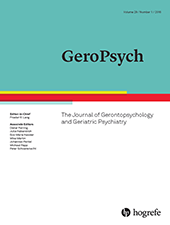Education, Occupational Class, and Cognitive Decline in Preclinical Dementia
Abstract
Abstract. We investigated education and occupational influences as markers of cognitive reserve in relation to cognitive performance and decline on multiple fluid and crystallized abilities in preclinical dementia. From the total sample of 702 participants stemming from the OCTO-Twin Study (Sweden), aged 80+ at baseline in 1992–1993, only those who developed dementia during the study period (N = 127) were included in these analyses. Random effects models were used to examine the level of performance at the time of dementia diagnosis and the rates of decline prior to diagnosis. The results demonstrated that both fluid and crystallized abilities decline in preclinical stages, and that education and occupational class have independent moderating roles on the cognitive performance at the time of diagnosis, but not on the rates of decline.
References
(1995). Predictors of cognitive change in older persons: MacArthur studies of successful aging. Psychology and Aging, 10, 578–589.
(1980). Diagnostic and statistical manual of mental disorders (3rd ed.). Washington, DC: Author.
(2004). Normal cognitive changes in aging. Australian Family Physician, 33, 783–787.
(2011). The effect of education on the onset and rate of terminal decline. Psychology and Aging, 26, 339–350.
(1997). The role of heredity in late-onset Alzheimer disease and vascular dementia. A twin study. Archives of General Psychiatry, 54, 264–270.
(2004). An integrated epigenetic and genetic approach to common human disease. Trends in Genetics, 20, 350–358.
(2007). Education provides cognitive reserve in cognitive deterioration and dementia. Neurologia, 22, 78–85.
(1963). Theory of fluid and crystallized intelligence: A critical experiment. Journal of Educational Psychology, 54, 1–22.
(2012). Benefits of educational attainment on adult fluid cognition: International evidence from three birth cohorts. International Journal of Epidemiology, 41, 1729–1736.
(2001). The NART as an index of prior intellectual functioning: A retrospective validity study covering a 66-year interval. Psychological Medicine, 31, 451–458.
(1996).
Introduction: Explaining class inequality in education. The Swedish test case . In R. EriksonJ. O. JonssonEds., Can education be equalized? The Swedish case in comparative perspective (pp. 1–63). Boulder, CO: Westview.(2007). Clinical predictors of progression to Alzheimer disease in amnestic mild cognitive impairment. Neurology, 68, 1588–1595.
(1975). Mini-Mental State. A practical method for grading the cognitive state of patients for the clinician. Journal of Psychiatric Research, 12, 189–198.
(2007). Education delays accelerated decline on a memory test in persons who develop dementia. Neurology, 69, 1657–1664.
(2000). A change point model for estimating the onset of cognitive decline in preclinical Alzheimer’s disease. Statistics in Medicine, 19, 1555–1566.
(2010). Toward an integrative science of life-span development and aging. Journal of Gerontology. Series B: Psychological Sciences and Social Sciences, 65B, 269–278.
(1967). Age differences in fluid and crystallized intelligence. Acta Psychologica, 26, 107–129.
(1995). Prevalence and incidence of dementia in the oldest old: A longitudinal study of a population-based sample of 84–90-year-olds in Sweden. International Journal of Geriatric Psychiatry, 10, 359–366.
(1997). Substantial genetic influence on cognitive abilities in twins 80 or more years old. Science, 276, 1560–1563.
(1997). Brain reserve and the clinical expression of Alzheimer’s disease. Geriatrics, 52 Suppl 2, S50–S53.
(2002). The Swedish Twin Registry in the third millennium. Twin Research, 5, 427–432.
(2004). Mild cognitive impairment as a diagnostic entity. Journal of Internal Medicine, 256, 183–194.
(2011). Terminal decline from within- and between-person perspectives, accounting for incident dementia. Journal of Gerontology. Series B: Psychological Sciences and Social Sciences, 66, 391–401.
(2014). Longitudinal design considerations to optimize power to detect variances and covariances among rates of change: Simulation results based on actual longitudinal studies. Psychological Methods, 19, 133–154.
(2005). A life course approach to cognitive reserve: A model for cognitive aging and development? Annals of Neurology, 58, 617–622.
(2010). Mild cognitive impairment in clinical care: A survey of American Academy of Neurology members. Neurology, 75, 425–431.
(2005). Extending neuropsychological assessments into the primary mental ability space. Aging Neuropsychology and Cognition, 12, 245–277.
(1997). Selection bias in samples of older twins? A comparison between octogenarian twins and singletons in Sweden. J. Aging Health, 9, 553–567.
(2003). Correlated and coupled cognitive change in older adults with and without preclinical dementia. Psychology and Aging, 18, 672–683.
(2008).
Time-based and process-based approaches to analysis of longitudinal data . In S. M. HoferD. F. AlwinEds., Handbook on cognitive aging: Interdisciplinary perspectives (pp. 477–491). Thousand Oaks, CA: Sage.(2002). What is cognitive reserve? Theory and research application of the reserve concept. Journal of the International Neuropsychological Society, 8, 448–460.
(2009). Cognitive reserve. Neuropsychologia, 47, 2015–2028.
(2012). Cognitive reserve in aging and Alzheimer’s disease. The Lancet Neurology, 11, 1006–1012.
(1999). Rate of memory decline in AD is related to education and occupation: Cognitive reserve? Neurology, 53, 1942–1947.
(2010). Neuroscience: Epigenetics and cognitive aging. Science, 328, 701–702.
(2004). Incidence and risk factors for mild cognitive impairment: A population-based three-year follow-up study of cognitively healthy elderly subjects. Dementia and Geriatric Cognitive Disorders, 17, 196–203.
(2006). Brain reserve and dementia: A systematic review. Psychological Medicine, 36, 441–454.
(2009). Classification models for early identification of persons at risk for dementia in primary care: An evaluation in a sample aged 80 years and older. Dementia and Geriatric Cognitive Disorders, 28, 567.
(2007). Terminal cognitive decline: Accelerated loss of cognition in the last years of life. Psychosomatic Medicine, 69, 131–137.
(2004). Education and the course of cognitive decline in Alzheimer disease. Neurology, 63, 1198–1202.


